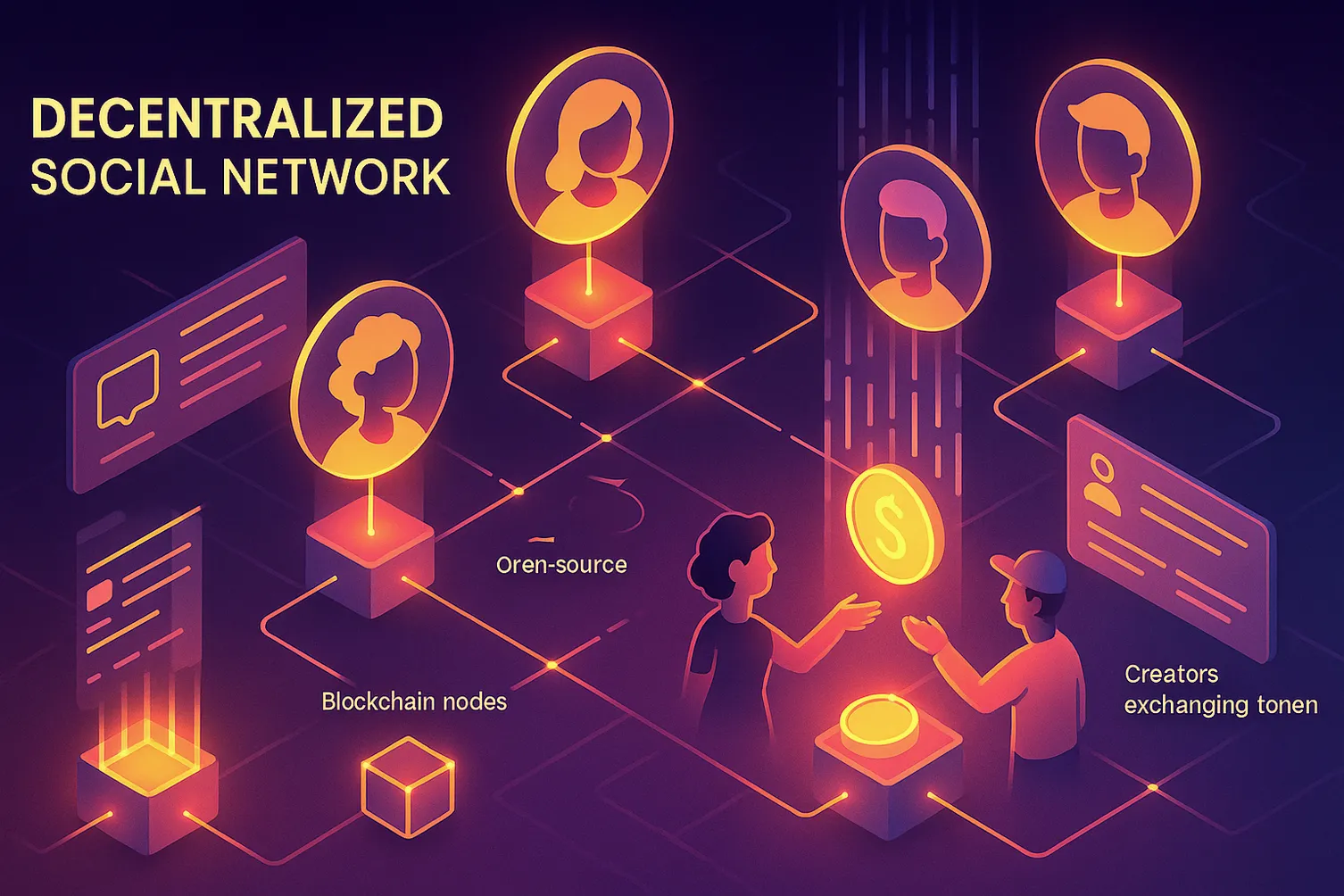Everything about social media is up for debate right now: who owns your audience, who gets paid, who decides what you see, and who can take it all away. The most intriguing question on the table is the one many builders whisper and many users now ask out loud: Can Blockchain Revolutionize Social Media?
This isn’t a hype-cycle thought experiment. It’s about re-architecting the incentives, data, and governance rails that power the feeds we live in. Below is a practical, candid exploration of what blockchain can change, what it might break, and what a credible Web3 social stack actually looks like for real users—not just early adopters.
What’s broken in today’s social platforms
- Platform lock-in: your social graph and content aren’t portable. If a platform bans you or changes direction, years of work vanish.
- Misaligned incentives: ad-driven models optimize for engagement, not wellbeing or creator sustainability.
- Opaque algorithms: ranking systems are black boxes, and appeals processes can be Kafkaesque.
- Monetization barriers: creators often need multiple intermediaries and lose meaningful revenue to fees.
- Data and identity fragmentation: your identity is scattered across apps; verification is inconsistent and brittle.
These issues aren’t new. But blockchain offers a different set of primitives to rethink them.
The blockchain primitives that matter for social
- Programmable ownership: smart contracts define who owns profiles, posts, and social graphs, not a single company.
- Data portability: standardized, open schemas make your identity and follows portable across apps.
- Composability: new social apps can plug into shared protocols the way DeFi protocols stack and interoperate.
- Native payments: tipping, subscriptions, and revenue sharing work out of the box with stablecoins and tokens.
- Transparent governance: DAOs and on-chain voting enable auditable policy changes and community moderation funds.
Together, these primitives craft a credible answer to the question: Can Blockchain Revolutionize Social Media? For certain parts of the social stack, the answer looks like a qualified yes.
What blockchain can actually improve right now
1) Real content ownership and portability
- Profiles, posts, and follows can be tokenized or recorded on-chain (or anchored to it) so they’re portable between clients.
- Open social graphs let users move to new apps without rebuilding networks from scratch.
2) Direct creator monetization
- Micropayments, tips, and subscriptions using stablecoins reduce fees and friction.
- Token-gated communities let creators control access without heavyweight SaaS stacks.
- Revenue splits become programmable, paying collaborators instantly.
3) Composable social experiences
- Developers can build clients atop shared protocols (think Lens or Farcaster) and focus on UX rather than re-building graphs.
- New features—reputation modules, curation markets, AI-curated feeds—can be added permissionlessly.
4) Transparent, pluralistic moderation
- Moderation can be layered: shared open data plus client-specific filters and community-curated blocklists.
- Funding for moderation can be handled via DAOs or protocol fees, with visible rules and appeal processes.
5) Economic incentives that reward quality
- Tokens or points can reward contributions that communities value (caution required; more below).
- Reputation primitives—non-transferable badges, attestations, or verifiable credentials—can strengthen trust.
Where blockchain still struggles
- Storage costs: full posts, images, and video don’t belong on main chains. Use IPFS, Arweave, or hybrid storage.
- UX friction: seed phrases, gas fees, and wallet confusion repel mainstream users; smart wallets and gasless flows are essential.
- Sybil attacks and spam: tokens attract farming; proof-of-personhood and rate limits are necessary.
- Regulation and compliance: tokens add legal complexity; ad targeting faces evolving privacy law.
- Network effects: even with open graphs, moving people en masse is hard; bridges to Web2 are pragmatic.
The takeaway: blockchain is a powerful substrate for identity, payments, and governance, but you must design a hybrid architecture.
A practical Web3 social architecture
- Identity and profiles: DIDs, ENS/handles, and verifiable credentials. Support phone/email login with smart wallet abstraction.
- Social graph: on an L2 rollup (e.g., Optimistic or zk) with cheap transactions and fast finality.
- Content storage: IPFS or Arweave for media; content hashes anchored on-chain for integrity.
- Payments: stablecoins for tips and subscriptions; programmable splits for collaborators.
- Moderation: open labels, client-side filters, and community-operated reputation services.
- Privacy: zero-knowledge proofs for selective disclosure, private groups, and age/region checks without doxxing.
- Gasless UX: meta-transactions or sponsored gas; session keys for smooth mobile experiences; passkeys or social recovery.
This hybrid approach retains the strengths of decentralization without punishing users with complexity.
Web3 social vs fediverse vs Web2
- Web2: great UX, closed graphs, opaque rules, strong network effects.
- Fediverse (ActivityPub): federation and portability without tokens; moderation distributed to servers; adoption growing.
- Web3 social: economic and governance primitives native to the protocol; open innovation but with added complexity.
In practice, these can and should converge: you can expose ActivityPub bridges from a web3 social protocol and let users roam.
Token design that won’t implode your community
- Prefer utility over speculation: emphasize access, boosts, or curation rights rather than price pumps.
- Use non-transferable reputation for trust; avoid tradable “rep” to reduce perverse incentives.
- Cap rewards with decay and anti-Sybil checks (proof-of-humanity, in-person verification, or web-of-trust attestations).
- Stablecoin-first payments: creators don’t want market risk for rent or groceries.
- Progressive decentralization: start with off-chain rate limits, move critical state on-chain as you prove demand.
Monetization patterns that actually work
- Crypto tipping and paid DMs with rate limits to deter spam.
- Membership NFTs or token-gated spaces with monthly stablecoin subscriptions.
- Paywalled posts via encrypted content keys released on payment.
- Community treasuries that fund moderators, curators, and feature bounties with transparent accounting.
If you’re a creator, you’ll also want a reliable on/off-ramp and trading venue to manage earnings from these models. That’s where a trusted exchange matters. You can register on BTCC using invite code NEWER to swap rewards, manage stablecoins, and cash out when needed.
Case studies worth watching
- Farcaster: a sufficiently decentralized protocol on Optimism with a growing client ecosystem and frames for app-like posts.
- Lens Protocol: profile NFTs and an open social graph on a low-cost chain with modularity for curation and monetization.
- Mirror and Paragraph: publishing with on-chain monetization and collectable posts.
- Audius: creator-first music streaming with tokenized incentives.
- Steem/Hive: early experiments in tokenized social incentives and content rewards.
Each shows progress on portability and monetization, though none have fully solved spam, UX, or mainstream onboarding.
Governance and moderation that scale without chaos
- Multi-layer moderation: protocol-level safety rails, client-level filters, and community-run labeling services.
- Clear appeals: transparent logs for takedowns and ban reasons; time-bound review windows.
- Jurisdiction-aware settings: region-specific compliance rules without global overreach.
- Funding: protocol fees or community treasuries pay moderators, not shadowy ad markets.
Moderation will always be political. The win is making rules legible, portable, and contestable.
Privacy, identity, and safety
- Selective disclosure with zero-knowledge proofs to verify age or uniqueness without exposing PII.
- Encrypted DMs and private groups with key management abstracted via smart wallets.
- Blended identity: pseudonymous by default, verifiable when necessary for access or payouts.
Building a credible MVP in 90 days
1) Start with a narrow, high-value community—writers, devs, or photographers.
2) Use an L2 for the social graph and stablecoins for payments; keep media off-chain.
3) Ship gasless onboarding with email/phone and passkeys; add social recovery.
4) Implement minimal viable moderation: block/label lists, report flows, and rate limits.
5) Launch with two monetization primitives: tips and paid posts; measure retention and creator revenue.
6) Expose an SDK so others can build clients or plugins on your open data.
When creators begin to earn reliably, they will come—and they’ll need crypto rails that feel invisible. If you’re funding or participating in this ecosystem, it’s useful to have accounts ready on trusted venues. Create an account at BTCC with invite code NEWER to on-ramp, access stablecoins, and manage tokens tied to social apps.
Metrics that matter beyond vanity
- Creator earnings per active user and revenue stability (month-over-month variance).
- Content integrity: percentage of posts with verifiable provenance (on-chain hash match).
- Safety: spam incidence per 1,000 DMs; time-to-human-review for reports; transparency of moderation logs.
- Portability: fraction of users who successfully export or import their social graph.
- UX friction: wallet-related failure rate, gasless transaction success, and average time to first post.
FAQs for realists
- Is a token required? No. You can start with stablecoins and non-transferable reputation; add a token only if it unlocks real utility.
- What about energy use? Modern chains are proof-of-stake with vastly lower energy footprints than PoW.
- Can we do privacy-compliant ads? Yes, via on-device models and zk attestations for segment membership without sharing raw data.
- Will regulators allow this? Design for KYC-able payouts, region-aware compliance, and clear risk disclosures. Work with counsel early.
- Isn’t the fediverse enough? It solves portability and decentralization without tokens; blockchain adds native economics and programmable governance. Many projects will bridge both.
A quick checklist for teams
- [ ] Gasless onboarding with passkeys or social recovery
- [ ] Stablecoin-first payments, programmable splits, transparent fees
- [ ] Open social graph with export/import tools
- [ ] Layered moderation with public labels and appeal logs
- [ ] Privacy by default with zk-enabled verification for gated spaces
- [ ] SDKs and client diversity to avoid single-client capture
- [ ] Analytics that measure creator revenue, not just DAU
For creators and power users exploring Web3 social, it helps to set up reliable rails to move value in and out. Register at BTCC with invite code NEWER so you can tip, subscribe, and manage earnings from tokenized communities with minimal friction.





